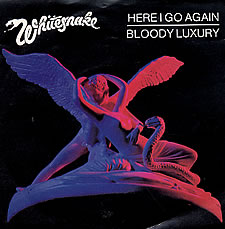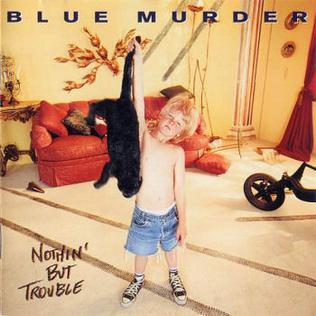
Whitesnake are an English hard rock band formed in London in 1978. The group was originally put together as the backing band for singer David Coverdale, who had recently left Deep Purple. Though the band quickly developed into their own entity, Coverdale is the only constant member throughout their history.
King Kobra is an American heavy metal band founded by drummer Carmine Appice after his tenure with Ozzy Osbourne from 1983 to 1984.

Raymond Arthur Gillen was an American rock singer. He is best known for his work with Badlands, in addition to his stint with Black Sabbath in the mid-1980s and recording most of the vocals on Phenomena's Dream Runner album.

Carmine Appice is an American rock drummer. He is best known for his associations with Vanilla Fudge; Cactus; the power trio Beck, Bogert & Appice; Rod Stewart; King Kobra; and Blue Murder. He is also Vinny Appice's older brother. Appice was inducted into the Classic Drummer Hall of Fame in 2013 and the Modern Drummer Hall of Fame in 2014.

Vincent Samson Appice is an American rock and metal drummer best known for his work with the bands Dio, Black Sabbath, and Heaven & Hell. Of Italian descent, he is the younger brother of drummer Carmine Appice.

John James Sykes is an English guitarist, best known as a member of Whitesnake, Thin Lizzy and Tygers of Pan Tang. He has also fronted the hard rock group Blue Murder and released several solo albums.

The Firm were a British rock supergroup formed in 1984, featuring singer Paul Rodgers, guitarist Jimmy Page, drummer Chris Slade, and bassist Tony Franklin. The band released two albums in 1985 and 1986 and eventually saw their greatest chart success with the songs "Radioactive", "All the King's Horses", and "Satisfaction Guaranteed".

Blue Murder is the debut album by English hard rock band Blue Murder, released on 24 April 1989 by Geffen Records. It was produced by Bob Rock. The band was formed by guitarist John Sykes after his dismissal from Whitesnake. He was eventually joined by bassist Tony Franklin and drummer Carmine Appice. The band entered Little Mountain Sound Studios in early 1988 to begin recording their debut album. After several unsuccessful attempts at finding a lead singer, John Sykes took up the role, having already sung the band's first demos. Following the record's release, Blue Murder embarked on tours supporting Bon Jovi and Billy Squier.

Philip Neil Murray is a Scottish musician, best known as the former bassist of Whitesnake, Brian May band, Black Sabbath and Gary Moore.

Badlands was an American heavy metal band founded by former Ozzy Osbourne guitarist Jake E. Lee, former Black Sabbath members Ray Gillen (vocals) and Eric Singer (drums), as well as former Surgical Steel bass player Greg Chaisson. After the first Badlands album, Singer was replaced by Jeff Martin. Compared to the sound of the members' former bands, the sound of Badlands was more in an AC/DC-influenced blues/hard rock vein. The group lasted from 1988 to 1993 and released three albums. Badlands (1989) and Voodoo Highway (1991) were released before Gillen left and was replaced by singer John West from New York. Gillen's death in 1993 effectively ended any hopes of reuniting the project. The album Dusk was released in 1998 with then-recently deceased Gillen on vocals.

Slide It In is the sixth studio album by British hard rock band Whitesnake. Originally released on 30 January 1984 in Europe, by Liberty/EMI, it was remixed for the American market, later issued on 16 April 1984 in North America by Geffen. In Japan, it was issued a "European" Mix release date on 23 March 1984, and an "American" remix on 29 December 1984 by CBS/Sony. Widely regarded as a moderate success, it helped the American market to open up for the band's sound and breakthrough throughout the later 1980s. Historically, it was the final Whitesnake recording to use the band's original "snake" logo.

"Is This Love" is a song by British rock band Whitesnake. It was released in 1987 as the second single from their self-titled album.
Lynch Mob is an American hard rock band, formed in 1989 by former Dokken guitarist George Lynch, who is the band's only permanent member.

Anthony James Franklin is an English rock musician, best known for his work on the fretless bass guitar with Roy Harper, The Firm, Jimmy Page, Paul Rodgers, John Sykes' Blue Murder, David Gilmour, Kate Bush, Whitesnake, Lou Gramm, Gary Hoey and most recently with Kenny Wayne Shepherd.

"Here I Go Again" is a song by British rock band Whitesnake. Originally released on their 1982 album, Saints & Sinners, the power ballad was re-recorded for their 1987 self-titled album. It was re-recorded again the same year in a new "radio-mix" version, which was released as a single and hit No. 1 on the Billboard Hot 100 chart on 10 October 1987, and also No. 9 on the UK Singles Chart on 28 November 1987. The 1987 version also made No. 1 on the Canadian RPM singles chart on 24 October 1987. In 2018 at the BMI London Awards, it received the "5 Million Performances Award", while in 2022 it garnered the "8 Million-Air Award".

Marco Mendoza is an American bass guitarist who has worked in diverse genres. He became a professional rock musician in 1989 and debuted on Black Sabbath drummer Bill Ward's solo album Along the Way. He has performed on a number of notable releases throughout his career, including Live... in the Still of the Night by Whitesnake, One Night Only by Thin Lizzy and Live in Concert at Lollapalooza by Journey.

Nothin' But Trouble is the second and final studio album by hard rock band Blue Murder. Released on 31 August 1993 by Geffen Records, the album was produced by the band's vocalist-guitarist John Sykes.

"Still of the Night" is a song by the English band Whitesnake. It was released as the first single from their self-titled 1987 album. It reached #16 in the U.K., #18 on the U.S. Mainstream rock Tracks and #79 on the Billboard Hot 100.

Whitesnake is the seventh studio album by British rock band Whitesnake, released on 23 March 1987 by Geffen Records in the US, and by EMI Records in the UK one week later. It was co-written and recorded for over a year in what would be the first and final collaboration between vocalist David Coverdale and guitarist John Sykes, as well as the final album to feature longtime bassist Neil Murray. The album, besides its commercial success, is remarkable for the band's change to a more modern glam metal look and sound, and the first recording to use the band's new logo which would characterise them in the future.

Joel Hoekstra is an American guitarist currently in the band Whitesnake. Hoekstra also tours as a guitarist for Trans-Siberian Orchestra. The son of classical musicians, he started out playing cello and piano at a young age, but it was hearing Angus Young of AC/DC that inspired him to start playing the guitar. He was raised in the suburbs of Chicago, in Orland Park, but has lived in New York City since 2001.



















